Updated 29 Jun 2014
|
WIRKSWORTH Parish Records 1600-1900
|
|
Thomas and Ann WEBSTER |
of Wirksworth and New Zealand |
Thomas Webster was born in 1835 in Wirksworth, second son
of John and Mary and 5th child of 6. He married Ann Rose
at the age of 28, and set out for New Zealand and a new life.
Perhaps the Cotton Famine encoraged them to go.
The Suez Canal was opened 5 years later, Thomas and Ann had to
sail round The Cape, a journey of 140 days in a Barque, the
Anne Dymes. Shortly after
they arrived in New Zealand, their first child Albert was born in 1864.
John Webster was a builder and Thomas learned his trade from his father.
He built himself a fine house in Blenheim,
which 120 years later was
known as the "old Webster House", was a listed building, and was moved
on wheels to conserve it (it was sadly destroyed by fire in 2005).
Thomas and Ann also raised 9 children (1 died).
In 1889 his elder brother John died, and Thomas came into an
inheritance of
the family house in St Mary's Gate, Wirksworth; a Tape Mill in Gorsey Bank
and 3 workers cottages by the Mill.
Full of energy, ten of the family sailed back to England via the Suez Canal.
His eldest daughter Mary Alice had just married and she stayed in New Zealand.
Thomas eldest son Albert postponed his marriage to return to Wirksworth,
then returned to New Zealand where he married on 4 Oct 1893.
By Oct 1889 two of Thomas' children were into a
Wirksworth junior school.
Two years later Thomas died, the Mill was taken over by Thomas junior.
After all their adventures and travels, John and Annie now lie at rest
in Wirksworth Cemetery. See emails for other information.
There are at least four Mills in the Area, ownership
is rather complex.
There are still some outstanding problems, which may
change this story! See also Credits.
|
Thomas Webster 1835-92
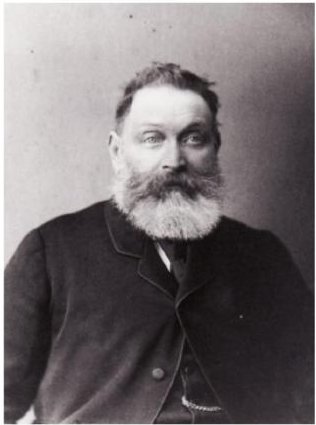 |
Ann Webster nee Rose 1841-1915
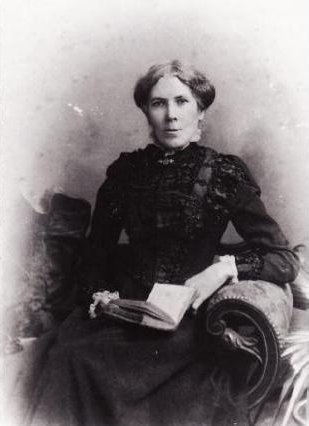 |
Family home, St Marys Gate, Wirksworth
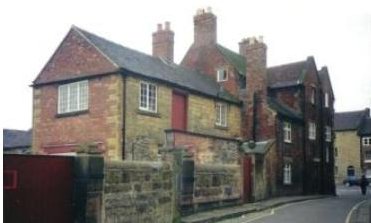
|
Webster's Tape Mill complex,
and 3 cottages, Water Lane, Gorsey Bank
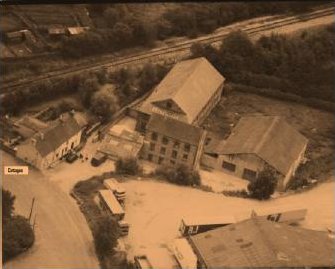 |
Home in Blenheim NZ, built 1874
Being relocated from 67 Grove Rd to 2 Dillons Point Rd.
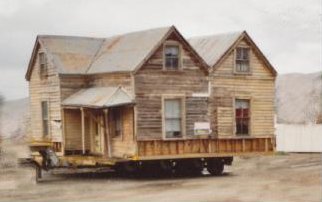 |
WEBSTER's Willowbath Mill |
Mill Yard cottages, Water Lane
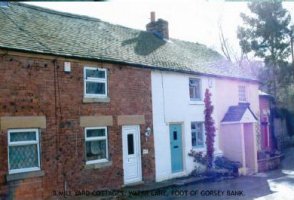 |
Websters Tape Mill, Water Lane
(bottom of Gorsey Bank, SK288533, 140m ASL)
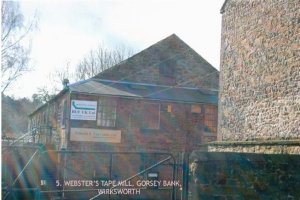 |
Websters Tape Mill, Water Lane
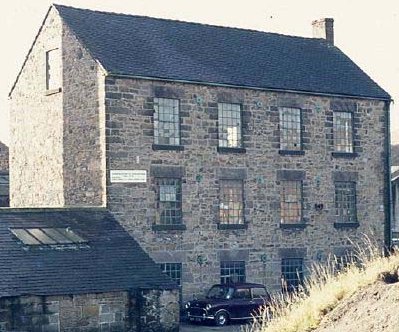 |
"Providence Mill, top of Gorsey Bank (SK290531), was first
recorded in
1823, weaving narrow fabric. A mill leat once ran beneath
it.
Adjacent houses are of the same period."
Derbyshire Heritage, Mills Index
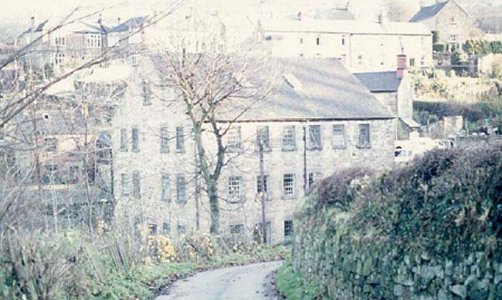
|
Owned by William Tatlow, Providence Mill
at the top of Gorsey Bank (168m ASL)
taken about 1920, see X467
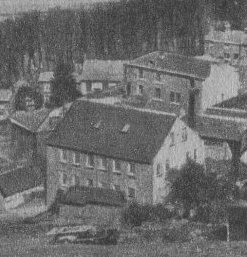 |
|
- Which ship did Thomas Webster sail to NZ? How long did it take?
- Which ship did Thomas Webster sail back to UK/ How long did it take?
- Details of Wills of:
Jeremiah Tatlow 1855, James Tatlow 1889, William Tatlow
Mary Tatlow nee Webster 1883, John Webster 1889
|
Marlborough Express 27 Jun 2005 |
Historic home razed by fire. |
A historic Blenheim house was destroyed by fire in the early hours of
yesterday morning. Police are interested in hearing from three youths
who were seen in the area shortly before the fire broke out at 4.30am
in the building at 2 Dillons Point Rd, near the Stock Food Mill.
The building known as the "old Webster House" was listed as a Class A
building by the Historic Places Trust and owner Brian Simpson said
"there was nothing else like it in Blenheim".
The house, which is believed to have been 119 years old, was unique
because of its age and architectural style, which featured a steep
gabled roof, four bedrooms and a parlour.
Mr Simpson, who bought the house four years ago, said he had been shocked
to be woken with the news of the fire.
"When the fire tenders got there, they just set up and it just collapsed
in front of them. It was a total write-off", he said.
Nobody had been living in the house, which had been gutted in preparation
for restoration work.
Chief Fire Officer Gary Price said the house was already engulfed in
fire when fire fighters arrived and nothing could be done to save the
building.
"It was a very old wooden building and was quite open, with no windows.
Once it caught alight it was quickly engulfed in flames" Mr Price said.
Twenty firefighters from the Blenheim Volunteer Brigade worked until 9am
to put out the fire.
Fire safety investigators from Nelson have visited the scene. The incident
is still under investigation but police would like to speak with the
youths to eliminate them from enquiries.
Mr Simpson said the building had been insured but he could still face a
financial loss.
"I have done an awful lot of work recladding and trying to get consents
from the council has been ongoing".
The house was originally situated on the corner of Budge St and Grove Rd,
and Mr Simpson had been familiar with it as former part-owner of Glenroy
Insulated Products, located nearby. The house had initially been moved
next to the Parker Grains Store opposite the railway satation after
Mr Simpson bought it in 2001, but it was moved to Dillons Point Rd
14 months ago. Mr Simpson reired a year ago and the restoration of the
house was to have been a major retirement project for him. Police said
the three youths were seen at 4.15am walking towards the railway station
wearing jackets and ****
|
Marlborough Express, Volume III, Issue 136 |
Death of Thomas Webster, jun. 1896 |
In a recent issue of the High Peak News (Derbyshire) the death by
accident of Mr Thomas Webster, jun., (aged 22 years) is announced.
Mr Webster was a member of a family who at one time resided in Grove
Road Blenheim, and on the death of a relative about seven years ago,
proceeded to England to take possession of property left them.
On arrival Home,
Mr Webster sen. carried on the tape business at Wirksworth. On the death
of the father, some two years later, young Thomas Webster entered
business at
the mill for his mother. Particulars of the accident are given as follows....
[broken spine - fall from horizontal bars]....
He was a single young fellow, devoted to his mother, brothers and sisters,
a very good business man, coupled with high principles, which endeared him to
everyone who knew him
|
Letter from Alice Mary, nee Coward about 1970 |
....But Grove Road of Blenheim was where our grandparents lived until
grand-dad [Thomas WEBSTER] had the tape-mill (or cotton mill) in
Derbyshire left to him. He must have got the first ship over to England
because your Dad & Mum [Albert Edward WEBSTER] had to postpone
their marriage, I understand, until your Dad could return after helping
grandma and our Aunts & Uncles on the voyage. My Mum [Mary Alice COWARD]
could not go as she & Dad [Charles COWARD] had been married just a short
time
|
Wirksworth Junior School admissions |
Admission Pupil DOB Parent Residence Last school/notes
07/10/1889 Joseph WEBSTER 17/11/1876 Thomas St Marys Gate New Zealand plumber
07/10/1889 Charles WEBSTER 07/09/1878 Thomas St Marys Gate New Zealand clerk
21/10/1890 Ada WEBSTER 12/07/1881 Thomas St Marys Gate New Zealand assisting at home
From "Yesterdays Journey", select "schools"
|
Somehow, the inheritance was willed from Jeremiah TATLOW to Thomas WEBSTER
via a complicated path
that I haven't manage to work out yet. Here's what
I've got so far:
TATLOW: A-B-C-D
WEBSTER: C-D-E-F-G
TATLOWs
1851 Jeremiah TATLOW manufactures Tape employs 140 persons. 1851
1855 Jeremiah TATLOW dies 28 Jul, aged 64 PRs
1861 James TATLOW is Tape manufacturer, employs 140 persons. 1861
1871 James TATLOW is smallware manufacturer, employs 107 hands. 1871
1881 William TATLOW, Tape Manufacturer, employs 2 men, 23 women. 1881
1881 James TATLOW, formerly smallware manuf, living with son John. 1881
1883 Mary TATLOW dies 29 Nov, at Gorsey Bank, aged 55 PRs
1889 James TATLOW dies, 9 Sep, aged 73 PRs
1891 William TATLOW, Gorsey Bank, Warehouseman Tape Manufactory. 1891
1899 William TATLOW dies in Sept, aged 77.
-----------------
WEBSTERs
1851 John Webster was a builder employing 10 men and living at
St Mary's Gate with his wife Mary nee HALL and five children.1851
1854 Mary WEBSTER nee HALL died 21 Jul aged 57.PRs
1861 Mary aged 33 was living in Hannage Road with her widowed father,
John, a builder aged 65 years, and younger siblings, John 31,builder,
Thomas 25, joiner, Eliza 23 unmarried. 1861
1863 Thomas, 27 builder/joiner, married Ann ROSE.
1864 Thomas and Anne left England to settle in New Zealand..
1868 John WEBSTER died aged 71 years. He left a Will. WEBSTER John 1868 Wirksworth.
Who were his beneficiaries? PRs
1871 John WEBSTER 41, Builder. Wirksworth was living with his wife Betsey
at St Mary's Gate. 1871
1889 John WEBSTER aged 59, died, 27 February 1889 and Thomas inherited?
Is there a will? PRs
1891 Census:
W532a William TATLOW Head W 68 M Warehouseman tape factory Derby
W532b Albert J TATLOW Son S 26 M Drapers assistant Gorsey Bank
W532c Mary A TATLOW Dau S 24 F Housekeeper Gorsey Bank
W532d Arthur C TATLOW Son S 21 M - Gorsey Bank
Mary has died, her brother John has inherited the properties, he has since
died, (his wife Betsey is living) but the properties have been passed on
to Thomas in New Zealand and yet Mary's husband William TATLOW and their
children are still alive in the 1891 census.
Thomas has returned from New Zealand, inherited the properties and taken
over the running of the mill and Mary's husband and children are working
elsewhere.
I could not find a TATLOW will to fit but John WEBSTER left a Will in 1868
(see above). Could Mary have been his beneficiary? How can I search that
will please John?
1892 Thomas died. He left a will in favour of Annie?
|
1794 1796
John 1825 Mary
WEBSTER=====v=====HALL
1868 | 1854
|
|
|--------|------|------|--|--------|--------|
| | | | | |
1826 1828 1830 1832 1835 1838
Hannah Mary John Ellen Thomas Eliza
| E WEBSTER |
| 1889 |
1828 1835 Marston 1841
Mary 1861 William Thomas 1863 Ann
D WEBSTER====v====TATLOW WEBSTER=====v=====ROSE G
C 1892 F | 1915
|
|
|--------|------|-------|------|--------|----|---|---------|-----|
| | | | | | | | |
1864 1865 1870 1872 1874 1876 1879 1882 1885
Albert Mary Annie John Thomas Joseph Charles Ada Ethel
Edward Alice 1951 1897 1896 Rose William
1916 | 1941
| |
| Mary
| Alice 1889 Charles
| WEBSTER=====v=====COWARD
|
1864 NZ 1872
Albert Marlboro Mary
Edward 1893 Searle
WEBSTER=====v=====MORCOM
1916 1960
|
|
|
[QC048]
..... In memory
of/JOHN WEBSTER /who died
June 25 1868 aged 72years/In
loving memory of/JOHN
WEBSTER who died
February27 1889 aged 59
years/also of BETSY widow of
the above named/who died at
Worksop November 19th
1898/in her
80thyear.(Limestone coped
stone)In/loving memory of
THOMAS WEBSTER/who died
June 27 1892/aged 57 years/also
of ANNIE/the beloved wife of
the above/THOMAS
WEBSTER/who died January
10th 1915/aged 73 years/also
of/THOMAS/son of/THOMAS
and ANNIE WEBSTER/who
died at Hollingwood
Oldham/December 29
1896/aged 22 years/In the
midst of life we are in
death.(FOX) (Marble cross
both in lge kerb)
|
|
1790 1791
Jeremiah 1811 Ann
A TATLOW=====v=====TURNER
1855 | 1861
|
|------------|-------------|--------|----------|---------------------------------------|
| | | | |
1814 1817 1819 1823 1828
John James Elizabeth William Benjamin
1836 | | |
| | |
| | |
1817 1817 1823 1828 1828 1833
James 1841 Sarah William 1861 Mary Benjamin 1853 Sarah
B TATLOW=====v=====MOORE C TATLOW=====v=====WEBSTER D TATLOW=====v=====LANGLEY
| | 1883 |
| | |
|--------|----|----| |-----------|-----|----|--------| |----------|-----|-----|---------|
| | | | | | | | | | |
1843 1845 1850 1863 1865 1867 1869 1856 1858 1861 1868
John James Edward William Albert Mary Arthur Ernest Ann Alice Helena
G J E J A.W. Charles Henry Elizabeth Mary Gertrude
m m m m.1891
Elizabeth Kate Emily Sarah
SHIPLEY Mary Elizabeth
HARLEY
|
|
1848 1853
John 1876 Ann
BOWMER=====v=====GAMBLE
1920 | 1933
|
|------|---------|--------|---|---|------|-----|--------|
| | | | | | | |
1878 1880 1881 1882 1884 1888 1890 1891
Annie Florence William George Ethel John Wilfred Herbert
BOWMERs in Census (Wirksworth area)
1851 W575 age 3
1861 W578 age 13
1871 W609 age 23 Clerk smallware manu, Silk
1881 W592 age 33 Manager Cotton tape factory
1891 W400 age 43 Smallware manufact
1901 W059 age 53 Cotton tape manufr
|
|
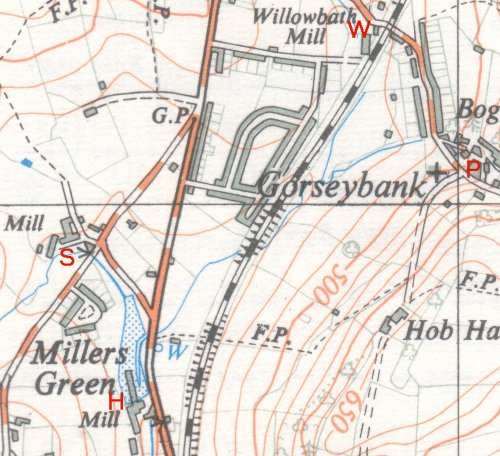
|
W Willow Bath Mill
(SK 288-533)
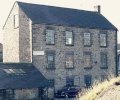 |
P Providence Mill
(SK 290-531)
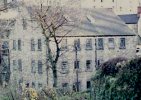 |
|
S Speedwell Mill
(SK 282-529)
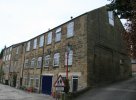 |
H Haarlem Mill
(SK 284-526)
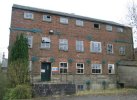 |
|
----Anyone with more details for publication on this webpage,
please email  ---- ----
-----------------
Elaine Dewhirst writes on 24 Oct 2011:
WEBSTER::
1881 John WEBSTER builder and surveyor is living at St Mary's Gate with his wife Betsy.
He is the brother of Thomas WEBSTER who is living in NZ.
1889 February 27, John WEBSTER, builder and Tape manufacturer has died. Probate granted is;
type 'Administration'. This means that John has not left a valid will.
1889 May 17, 'Administration' of the will is granted to John's wife Betsy.
1889 October, Thomas WEBSTER and his family have arrived in England from NZ.
The children are entered into Wirksworth Junior School 10 October .
1889 November, The will is resworn. The value of the will has increased.
1891 Thomas WEBSTER is a smallware tape manufacturer living with his family, at St Mary's Gate. Betsy has moved out..
1892 Thomas has died. He has left a will and a copy of it has been ordered.
Sorry to intrude with the WEBSTER 'stuff' but I needed to record it...
Can't keep my eyes open... How many nests have you built today?
Regards
Elaine
--------------
Heather Bowles writes 23 Oct 2011
Hello John,
Sorry , I couldn't help with the voyage of the "Ann Dymes" but I suspect I
know why the Websters left NZ. There was a worldwide depression in the 1880s
that was particularly severe in this country. The family can't have been too
badly hit by the depression though because fares were very expensive
compared to wages and many immigrants simply could not afford to return
'home'.
The links below to a NZ government history website explain the voyages and
the 1880 depression generally
www.teara.govt.nz/en/history-of-immigration/10
www.teara.govt.nz/en/the-voyage-out/1
Regards,
Heather
----------------
Elaine Dewhirst writes on 21 Oct 2011:
Hello John,
1889
Thomas WEBSTER and his family arrived back in Wirksworth from New Zealand in November 1889.
His brother John died in Wirksworth, 27 February 1889. John's Will was Resworn in November 1889 and
Thomas' children entered Wirksworth Junior School on 7 October 1889.
1864 Most likely arrival in New Zealand
Thomas and Ann WEBSTER nee ROSE arrived in New Zealand. on the Anne Dymes, Sailed from London,
October 13 1863 - arrived Nelson 3 March 1864. Their first child Albert Edward WEBSTER was born in
Nelson New Zealand 4 April 1864.
On board were Ann and Shaw Aroa. The Aroa family from the UK settled on a farm in the Awatere. Albert
worked on Richmond Brook Station in the Awatere. Lottie Aroa (probably a daughter of the family) was a
witness at Albert's and May WEBSTER's wedding. Thomas and Annie were not named on the passenger list
because they were probably travelling on the passage incentive scheme for emigrants.
Regards
Elaine Dewhirst
-----------------
Elaine Dewhirst writes on 21 Oct 2011:
Hello John,
Where did the rumour start?
There is no proof/reason to believe that Jeremiah Tatlow willed any property to Mary TATLOW nee WEBSTER
Mary TATLOW nee WEBSTER did not leave a Will. She did not Will any of her own or her husbands property to
her brother John WEBSTER
TATLOWs (in partnership) leased Arkwright's Haarlem Mill.
WEBSTER's owned the Mill Yard Cottages, Water Lane, at the foot of Gorsey Bank and a Tape Mill (Willow Bank Mill)
below the cottages.
John WEBSTER (the Elder) moved from St Mary's gate to Hannage Road. He died 25 June 1868 and left a will.
Probate was granted 14 September 1868 to his son, the sole executor, John WEBSTER (Jnr)
John WEBSTER Jnr, and his wife Betsy lived in the family home at St Mary's Gate. John Jnr
ied 27 February 1889. He left a will and his wife Betsy was granted Administration of his Personal
Estate on 17 May 1889. Thomas WEBSTER immediately returned to Wirksworth from New Zealand and the
Will was Resworn November 1889. Thomas took over the running of the Mill and the family lived in the
family home at St Mary's Gate.Wirksworth.
Thomas WEBSTER died two years later 27 June 1892 and left a Will. His wife Annie was granted
Probate.13 September 1892. and she took over the running of the Mill with a manager and her son Thomas (Jnr)
who died in an accident, at Oldham 29 December 1896, aged 22 years.
Annie WEBSTER died 10 January 1915 and left a Will. Her son Charles William WEBSTER was granted
Probate 18 November 1915.
I hope this sets the record straight.
Regards
Elaine Dewhirst
-------------
Elaine Dewhirst writes on 20 Oct 2011:
Haarlem Mill was sold in 1792 and the Thompson engine was replaced in 1814, when it was advertised as being
'in excellent repair'. The conversion for tape weaving in 1815 is said to have been by Maddley Hackett and
Riley, smallware manufacturers of Derby, and the name Haarlem Mill was acquired, after a works in Derby of
a similar name. Silk weaving was carried on in part of the site in the 1820s and it subsequently passed
through several hands until it was purchased by the Wheatcroft family, local tape manufacturers, in 1858.
Around this time the mill manager was Samuel Evans, uncle of the novelist George Eliot (1819 - 1880), who
is said to have based the characters Adam Bede and Dinah Morris, in her novel 'Adam Bede'(1859), on her
uncle and aunt, and used Haarlem Mill as the inspiration for the mill in 'The Mill on the Floss'(1860).
According to Stuart FLINT's letter James (Jas) and William TATLOW leased the Haarlem Mill and then
eremiah TATLOW took it over for a time before Joseph Wheatcroft of Cromford took it over....
Did Jeremiah TATLOCK purchase or lease the Haalem Mill?
I have searched again and have not found any relevant TATLOW Wills..
Regards
Elaine Dewhirst
------------
Elaine Dewhirst writes on 20 Oct 2011:
Hello John,
According to Stuart FLINT's letter James (Jas) and William TATLOW leased the Haarlem Mill and then Jeremiah TATLOW took it over for a time before Joseph Wheatcroft of Cromford took it over....
The Haarlem Mill was part of the Arkwright Estate and it was not for sale until the 1920s.
If there was no ownership then Jeremiah TATLOW could not have willed a Mill to Mary WEBSTER for her, in turn, to Will TATLOW Mill property to her brother John WEBSTER.
It looks as if WEBSTERs owned at least one Miil and according to Stuart FLINT's letter a second which became Green's Mill after WEBSTER's. I have searched for and never found Green's Mill...
Websters were owners of Water Bath Mill?
Regards
Elaine Dewhirst
---------------
Elaine Dewhirst writes on 20 Oct 2011:
Dear John,
There is no quick solution: Are the following Haarlem Mills and houses in Wirksworth or Gorsey Bank?
I tried sorting out who owned what Mill in 1999 and I think I'm more confused today.
I've attached some earlier emails including my first email ever from you. The paper trail is enormous.
I was so afraid my PC would blow up I printed everything...
TATLOW James [H. Mill houses, Wirksworth] Smallware manufacturer
TATLOW Jas. & Wm. [Haarlam Tape works,Mill houses, Wirksworth] Smallware Mnfr
TATLOW William [H. St. John's st, Wirksworth] Smallware manufacturer
I think searching the 'Wills' may sort out the property. I should take a look at the WEBSTER Wills. More later.
Regards
Elaine Dewhirst
--------------
Elaine Dewhirst writes on 19 Oct 2011:
Hello John,
Whose Mill is it? TATLOWs or WEBSTERs? I love the way you arrive at the answer. Clever you! Yes, 'Providence' is William TATLOWs and Water Lane is WEBSTERs. Then the worker's cottages must be below Water Lane Mill?
I have just read every word of your WEBSTER web page and it is so interesting. I love the mystery and I do hope it starts people thinking and looking in their attics.
If I had thought about it; I probably would have fainted at the thought of my photo being on the page but remembering our unanswered questions about the WEBSTERs. Where did they come from? Where and how did they live? What did they see and feel? What did they look like? These were our questions and we wanted answers and along came Jenni WADDELL with photos of Thomas and Annie WEBSTER so the least I can do is share a glimpse of a New Zealand WEBSTER.
The web photo of Annie and Thomas was a shared gift from our cousin Dr Jenni WADDELL of Auckland whose father, Alan HOOKINGS visited Wirksworth and met Valerie WEBSTER nee BENYON and David BEECH and brought us, at last, news of our Wirksworth family.
Jennie Abbottt-Barnaby of Kerikeri has added a precious original photo of Albert's children to the collection of New Zealand photos. My sister Jennifer Urry of Katikati, cousin Colin Stockwell of Omokoroa near Tauranga and our South Island cousins Les Baker, Betty Battersby and Gladys Norrie, and the ROSE family historian, Christobel TOMES of Blenheim, have brought together fragments of information to make a rich and exciting WEBSTER FAMILY HISTORY whereas previously, it had been a WEBSTER FAMILY FAMINE.
Nearing the stage when it is ready for the printer the WEBSTER FAMILY HISTORY will forever be a work in progress as we continue to gather the fragments of the past and keep on recording the present.
We appreciate your expertise, time and effort and thank you for an amazing page and the privilege of being added to your Website.
Regards
Elaine Dewhirst.
--------------
Elaine Dewhirst writes on 18 Oct 2011:
Hello John,
I am searching my paper files:
Stuart FLINT emailed:
Monday, February 13, 2006, 8.14 AM
William TATLOW who married Mary Webster Hannah's sister owned a Tape Mill
at the top of Gorsey Bank Wirksworth whilst Thomas and Anne Webster owned
the one at the foot of Gorsey Bank... My Uncle Arthur Botham (married my
father's sister Leah Amelia Flint born 1888) lived on Gorsey Bank... His
father Henry Botham who married into Wettons of Miller Green and his family
worked for both Tatlows and Websters Mills. Uncle Arthur Botham was a Pit
Deputy at Clipstone Colliery Nottinghamshire and Bolsover Colliery Derbyshire...
In his surface mail letter (2006) Stuart wrote:
(Edith married Charles Edward Blackwell Webster deceased Marker Garden
Owner of Storer Farm Ashlehay) ...Edith a widow lives near my home
today and is helping me unravel our family history.
The note about Edith was written at the bottom of a family tree record
titled: "The SPENCER FAMILY OF MRS EDITH WEBSTER NEE SPENCER. Edith's
husband was Edward Webster florist/Market Gardener Storer Farm Ashlehay "
Yesterday I searched the Probate Calendar 1861 - 1941
1868:
WEBSTER John: Death Date 25 Jun, Probate Date: 14 Sep 1868 Derbyshire,
England Registry: Derby. The Will of John Webster the Elder late of
Wirksworth in the county of Derby.....was proved by the oath of John
Webster of Wirksworth Builder the son of the Sole Executor.
1889:
WEBSTER John:Death Date 27 Feb, Probate Date: 17 May 1889 Derbyshire,
England Registry Derby 17 May Administration of the Personal Estate of
John Webster in the County of Derby Builder and Tape manufacturer who
died 27 Feb 1889 at Wirksworth was granted at Derby to Betsey Webster
of Wirksworth. Widow of the Relict
Personal Estate:£2,977 4s
Resworn November 1889: BP 5280 6s 3d
1892
WEBSTER Thomas:Death Date 27 Jun, Probate Date: 13 Sep 1892 Derbyshire,
England. Thomas of Wirksworth Derbyshire tape manufacturer died 27 June
1892 Probate Derby 13 September to Annie Webster widow and John Gratton
solicitor's clerk. Effects: £1,530.7s.5d Registry: Derby
1915
WEBSTER Annie:Death Date 10 Jan, Probate Date: 18 Nov 1915 Derbyshire,
England. Registry: London. Annie of Saint Mary's Gate Wirksworth Derbyshire
widow who died 10 January 1915 Probate London 18 November to Charles
William Webster, tape manufacturer and John Gratton solicitor.
effects £4,091 2s 2d
Regards
Elaine Dewhirst
--------------
Trevor Simpson writes on 17 Oct 2011
Around 1864 I think ships would have been pure sail, especially to go
the long way round and probably not non stop. Around 1889 probably
steam and sail. They didn't have steamships well enough developed and
able to carry enough coal till later. I've been looking at Brunel's
ships such as SS Great Britain and that was eventually converted to
pure sail. His Great Eastern/ Leviathan was built with the intention
of going to Aus non stop but had various problems including doubts
about using the Suez Canal when it opened later. It took some
evolution for ships to make the journey under steam and eventually
keep to reliable passage times. It's worth looking at the web sites
for Brunel's ships to get an idea.
Maybe there are web sites or offline records for typical ships or the
actual ships that your people sailed or steamed on.
--------------
Elaine Dewhirst writes on 17 Oct 2011:
I am pretty certain that no proceeds from John WEBSTER's 1868 Will ever
reached New Zealand. The New Zealand family had little knowledge of our
English roots (except that we came from England) until about 20 years ago.
My father lost his father to illness when he was eleven years old and in
those days everyone was too busy to ask questions.(and there was WW11)
It was the saddest thing not knowing... It appears that after Thomas and
Annie returned to England and after my grandfather Albert returned to NZ;
the families did not keep in touch.
I always meant to look up the exact dates of the downturn in the cotton
industry and having done so today I am interested to see they co-incide
with Mary WEBSTER's marriage to William TATLOW in 1861. Mary's father
died in 1868. Could it be that there were some financial adjustments
necessary giving Mary certain rights (honoured by a handshake or is there
a title??) which at her death in 1883 allowed her to claim her right to
certain TATLOW family property? That being the Gorsey Bank Mills. Otherwise
you would have to question the legal right to probate.
"The Lancashire Cotton Famine, also known as The Cotton Famine or the Cotton
Panic (1861–1865), was a depression in the textile industry of North West
England, brought about by the interruption of baled cotton imports caused
by the American Civil War. The boom years of 1859 and 1860 had produced
more woven cotton than could be sold and a cutback in production was needed.
The famine of raw cotton and the difficult trading conditions caused a
change in the social circumstances of the Lancashire regions's extensive
cotton mill workforce. The factories ran out of raw cotton to process,
large parts of Lancashire region's working society became unemployed, and
went from being the most prosperous workers in Britain to the most impoverished."
-
Wikipedia
|
What do you think?
Regards
Elaine Dewhirst
--------------
John Palmer writes on 16 Oct 2011:
Hello Mike,
Many thanks for the information about the WEBSTER children at Wirksworth
School 7 Oct 1889
This has put limits on the voyage Thomas WEBSTER made back to Wirksworth
from NZ in 1889,
see www.wirksworth.org.uk/X636.htm
Thomas WEBSTER plus wife plus 8 children made the voyage because his elder
brother John died
27 February 1889 at Wirksworth, leaving Thomas a Tape Mill at Gorsey Bank,
worker's cottages
and family house in St Marys Gate Wirksworth .
Did John leave a Will? Who were his beneficiaries.? Can you advise about
this Will?
Surely all the property involved would delay the Probate? Did Thomas travel
before
Probate?
NZ was connected to UK by cable in 1876, so news of the death could have
reached Thomas
fairly quickly. The Suez Canal was opened in 1869 so the trip back would
have been quicker
than via the Cape. But Thomas had only 7 months to close his business as a
Builder,
close his posh home in NZ (see above link), organise and make the voyage,
and persuade
Albert his eldest son to postpone his marriage and come with the family to
help.
Judging from the photo of Thomas, he was the kind of bloke who could do all
this!
Regards,
John Palmer, Dorset, England
--------------
Beryl Scammel writes on 15 Oct 2011:
In a book called "Dear Sister" which contains letters between 2 sisters-one
who
stayed in Monyash and the other who went to New Zealand it says that Jane
and children sailed from Liverpool in Sep 1856 . the cost was £112.10s
and
took exactly 3 months. From other comments it sounds like a sailing ship
called the Oliver Lang.
The book was edited by Dr Robin Holmes and Allan J Farley and I obtained it
from the Wairarapa Archive, 79 Queen St Masterton New Zealand.
It gives brilliant descriptions of early settlers in New Zealand
Regards
Beryl Scammell
--------------
|
|
A Barque
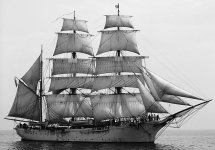 |
1863-64.
Barque "Anne Dymes", Captain Knight, from London,
arrived 2nd March.
Passengers, 53. £17 per adult.
The vessel was detained in Bay of Biscay for three weeks by storm.
A voyage of 140 days, 17,000 miles, averaging 120 miles per day, and 5 mph.
Gravesend (13 0ct), Equator (7 Dec), Cape (14 Jan), Tasmania (21 Feb),
Cape Egmont (29 Feb), Nelson (3 Mar).
|
|
Nelson Examiner and New Zealand Chronicle, 3 March 1864, Page 2
"The Anne Dymes. — This barque, Captain Knight, arrived in harbour yesterday,
after a protracted passage of 140 days from Gravesend. She is an India-built
ship, and this is her second voyage. The length of passage is owing to the
bad weather experienced the vessel being detained for three weeks in the
Bay of Biscay, and losing her fore-topmast and jib-boom, as already reported
in this paper. There are about fifty passengers, half of them being assisted
immigrants. One death occurred, that of Mrs. Hopkins, an elderly lady, who
died about three weeks since. The passengers speak highly of the captain
and officers, but complain of the shortness of provisions, as, for the
latter part of the voyage, there was no fresh or preserved meat, and the
passengers had to subsist on salt provisions only."
Shipboard Diaries - Passage to New Zealand
34 Diaries for 1814 to 1888, which give a feel for what shipboard life was
like on the long voyage from UK to NZ.
|
1.Ann and Shaw AROA |
3.Elizabeth and Mary BREMNER |
5.Elizabeth BUDGE |
6.William COGAN
7.Margaret, Elizabeth, and Ellen CONNELL |
10.Ann E. COOK |
11.Robert COX |
12.Mary DOWNEY |
13.Elizabeth DRINKWATER |
14.Margaret FAHY |
15.Henry GERRISH |
16.Hugh and Jane GRAY |
18.John and Richard GREEN |
20.Henry HEPHZIBAH |
21.John HEPHZIBAH |
22.Louie HOPKINS |
23.Elizabeth HUNT |
24.W. JACKSON |
25.Annie LESTER |
26.W. J. M'LAREN |
27.William MILES |
28.Mary and Naomi PATCHING |
30.J. W. REDWORTH |
31.Mary REORDAN |
32.C., Ann, Ann P., and William REMNANT |
36.J. H., Louisa, and Joseph RICHARDS |
39.Maria SALOME |
40.Elizabeth SHARP |
41.Marcella and Anne SMITH |
43.Thomas and Ellen SNOOK |
45.Robert, Lynn, Henry, and Ellen STAPLES |
49.Elizabeth THOMSON |
50.Emma and Maryann WATKINS |
52.Edwin WATSON |
53.Harriet WEBBER
|
This barque, Captain Knight, arrived in our bay on
Wednesday, with upwards of 50 passengers. The following
is the report of the ships run:-
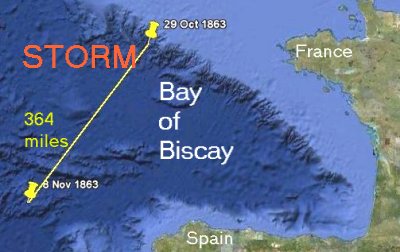 |
Barque rigging. In the Bay of Biscay storm,
the Anne Dymes LOST her
jib-boom and sails and foretop mast.
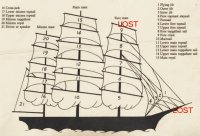 |
"Left Gravesend on the evening of October 13
1863, with fresh winds at West and South-west. On
the 29th October, in Lat 48 deg, 16 min N, and 10
deg 10 min W at 8.30 am, while hove too under
the lower main topsail and reefed mizen staysail, the
ship gave a sudden plunge forward, washing away the
jib-boom, gear and sails, at the same time carrying
away the foretop-mast, staving in the booby hatch
over the main hatch, two full water-casks, and washing
everything on deck to leeward, including spare
anchors, spars, ropes, &c, and tearing up and breaking
the ring bolts on the deck. Had all the passengers
passed aft into the poop, and got the main hatch
well secured, while we had a continuance of strong
gales from E and SW, with high sea, up to the
8 November, in Lat 43 deg 41 min N, 13 deg
58 min W, when the ship entered on a light and
variable trade wind. Crossed the line on 7th December;
rounded the Cape of Good Hope on the 14th
January; made Van Dieman's Land on 21st February,
running down between 45 and 46 deg S;
sighted Cape Egmont February 29th, and arrived in
Nelson on March 3rd."
|
The length of the voyage, 140 days, caused a shortness
of provisions, such as preserved meats, soups, &c,
which was considerably felt by the passengers, all of
whom speak in the highest terms of the Captain, as
can be seen by the following
TESTIMONIAL
"To F H Knight, Esq, Captain of the Barque Anne Dymes"
[continues]
|
|
 |
Most of the photographs and 15 years research
about the Webster family is kindly supplied by
Elaine Dewhirst of New Zealand, a direct descendant of Thomas Webster.
Her research is ongoing.
Anyone with more information please contact:

|
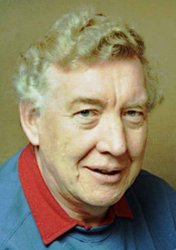 |
This webpage was built and handcoded by the
Wirksworth webmaster from data supplied by the Internet and
by emails between NZ and Dorset, England.
Anyone with suggested changes, contact:

|
THE COTTON FAMINE 1861-1864. |
Its effect on the population of Wirksworth. |
Compiled by Elaine Dewhirst. |
Wikipedia
The Lancashire Cotton Famine, also known as The Cotton Famine or the Cotton
Panic (1861–1865), was a depression in the textile industry of North West
England, brought about by the interruption of baled cotton imports caused
by the American Civil War. The boom years of 1859 and 1860 had produced
more woven cotton than could be sold and a cutback in production was needed.
The famine of raw cotton and the difficult trading conditions caused a
change in the social circumstances of the Lancashire regions's extensive
cotton mill workforce. The factories ran out of raw cotton to process,
large parts of Lancashire region's working society became unemployed,
and went from being the most prosperous workers in Britain to the most
impoverished.
|
Comment:
Cotton was no longer available and machines lay idle. A large amount of saleable property disappeared as values took a sharp downturn. Rates were increased to cover the shortfall and mill-owners and manufacturers who did not have cash-flow struggled. Many mill owners, failing to keep going, ended up as labourers or unemployed
In the fourth week of September 1861 in the manufacturing districts, of two million inhabitants, forty-three thousand five hundred were receiving parochial help. By the third week of November, the number had increased to over two hundred and fifty-nine thousand and the working classes were suffering from an extent of destitution which had never been known before. Employees, housed in mill owner’s cottages, were not asked to pay rent further reducing the mill owner’s income.
The government encouraged emigration and offered free passage to the colonies. Many desperate employees committed petty crimes in order to qualify for deportation.
Wikipedia
In 1860, there were 2,650 cotton mills in the Lancashire region, employing
440,000 people. They were paid in total £11,500,000 per annum.
90% were adults and 56% female. The mills used 300,000 HP of power, of which
18,500 was generated by waterpower. The mills had 30,387,467 spindles and
350,000 power looms. The industry imported 1,390,938,752 lb of raw cotton
a year. It exported 2,776,218,427 yards of cotton cloth and 197,343,655
pounds (89,513,576 kg) of twist and yarn. The total value of its exports was
£32,012,380.
|
Cotton Mills in 1860
Lancashire Cheshire Derbyshire
Mills 1920 200 25
Workers 310000 38000 12000
Of the 1,390,938,752 lb of raw cotton
1,115,890,608 lb came from America (80%).
Source of Raw Cotton
Country Imports
America 1,115,890,608
East Indies 204,141,168
West Indies 1,630,784
Brazil 17,286,864
Other 52,569,328
|
1860 saw the end of this period of rapid growth. The Cotton Famine of 1861–1865 was a period when American long staple cotton became unavailable due to an American Civil War. After the war, the economics of the industry had changed, and a new larger mill was required.
Cotton mill and water
The earliest cotton mills were driven by water, so needed to be situated on fast flowing streams. The labour force, in the main had carding, spinning and weaving skills acquired by working with wool. The earliest mills were adjacent to streams flowing off the open west facing moors where the rainfall was the highest. As capacity grew, navigable waterways were needed to bring in the raw materials and take away the finished yarn or cloth. Rivers were canalised and a network of canals was dug to penetrate further into the hills to service the mills.
From about 1820, the stationary steam engine became the normal form of power for a cotton mill, water was still needed to produce the steam and to condense it, to maintain the humidity, for many of the finishing processes and for firefighting. The water was extracted from rivers and canals, then later mills requiring ever more water, built and maintained their own reservoirs. Mills were built away from the hills, and clustered around watercourses, developing into mill towns. Mills were also used for wet finishing processes such as bleaching, dyeing and printing- these were very water intensive.
In March 1863, there were some sixty or seventy thousand women attending sewing school, and twenty thousand men and boys attending classes. They were thus defined as doing useful work so could legally receive aid under the Poor Law legislation. There remained a further twenty five thousand men receiving aid but not doing any work. To Victorian thinking this was a difficult problem, and some means was needed to provide paid work. Local authorities did have work that needed to be done- but no legal way to borrow to pay for it.[20]
On 19 January 1863, Abraham Lincoln sent an address thanking the cotton workers of Lancashire for their support. He wrote: ... I know and deeply deplore the sufferings which the working people of Manchester and in all Europe are called to endure in this crisis.
The Federal American government sent a gift of food to the people of Lancashire.
Public Works Manufacturing Districts Act 1864 became law 2 July 1863. This allowed public authorities to borrow money for public works. Cotton operatives could now be employed on useful projects. Blackburn, for example laid paving flags and built new sewers. [21]
Cotton starts to flow
A trickle of raw cotton reached Lancashire in late 1863, but failed to get to the worst affected regions, being swallowed up in Manchester. The cotton was adulterated with stones, but its arrival caused the principle operators to bring in key operators to prepare the mills. The American Civil War ended in April 1865. In August 1864, the first large Consignment arrived and Wooley Bridge mill in Glossop was able to reopen, giving all operatives a four and half day week. Employment then returned to normal. Raw cotton prices had risen from 6½d in 1861 to 27½d in 1864. [22]
HOME LIFE OF THE LANCASHIRE FACTORY FOLK DURING THE COTTON FAMINE.
(Reprinted from the Manchester Examiner and Times of 1862)
We called next at the cottage of a hand-loom weaver—a poor trade now in the best of times—a very poor trade—since the days when tattered old "Jem Ceawp" sung his pathetic song of "Jone o' Greenfeelt"—
"Aw'm a poor cotton weighver, as ony one knows;
We'n no meight i'th heawse, an' we'n worn eawt er clothes;
We'n live't upo nettles, while nettles were good;
An' Wayterloo porritch is th' most of er food;
This clemmin' and starvin',
Wi' never a farthin'—
It's enough to drive ony mon mad."
|
This family was four in number—man, wife, and two children. They had always lived near to the ground, for the husband's earnings at the loom were seldom more than 7s. for a full week. The wife told us that they were not receiving any relief,
LETTER AND SPEECHES UPON THE COTTON FAMINE
The Times of April 14, 1862, appeared the first of a series of letters,
pleading the cause of the distressed operatives. He said:-
"I am living in the centre of a vast district where there are many cotton
mills, which in ordinary times afford employment to many thousands of
'hands', and food to many more thousands of mouths. With rare exceptions,
quietness reigns at all those mills. . . . It may be that our material
atmosphere is somewhat brighter than it was, but our social atmosphere is
much darker and denser. Hard times have come; and we have had them
sufficiently long to know what they mean. We have fathers sitting in the
house at mid-day, silent and glum, while children look wistfully about,
and sometimes whimper for bread which they cannot have. We have the same
fathers who, before hard times came, were proud men, who would have thought
'beggar' the most opprobrious epithet you could have hit them with; but
who now are made humble by the sight of wife and children almost starving,
and who go before 'relief committees', and submit to be questioned about
their wants with a patience and humility which it is painful, almost
schocking, to witness, And some others of these fathers turn out in the
morning with long besoms as street-sweepers, while others again go to
breaking stones in the town's yard or open road-side, where they are
unprotected from the keen east winds, which add a little more to the
burden of misery which they have to bear just now. But, harder even than
this, our factory-women and girls have had to turn out; and, plodding a
weary way from door to door, beg a bit of bread or a stray copper, that
they may eke out the scanty supply at home. Only the other day, while
taking a long stroll in the country lying about the town in which I live,
I met a few of these factory-girls, and was stopped by their not very
beggar-like question of 'Con yo help us a bit?' They were just such as my
own sisters; and as I saw and heard them, I was almost choked as I fancied
my sisters come to such a pass as that. 'Con yo help us a bit?' asked these
factory girls.
On the 29th of April 1862, a meeting of gentlemen residents, called by
Thomas Goadsby, Esq., Mayor of Manchester, was held in the Town Hall of
that city, to consider the propriety of forming a relief committee...
Your fixed capital here is of no use without the population. It is of no
use without your raw material. Lancashire is the richest county in the
kingdom when its machinery is employed; it is the poorest county in the
kingdom when its machinery and fixed capital are paralysed, as at present.
Therefore, I say it is the interest, not only of this community, but of the
kingdom, that this population should be preserved for the time—I hope not
a distant time—when the raw material of their industry will be supplied
to this region.
SPEECH OF THE EARL OF DERBY
"'That the manufacturing districts of Lancashire and the adjoining counties are suffering from an extent of destitution happily hitherto unknown, which has been borne by the working classes with a patient submission and resolution entitling them to the warmest sympathy of their fellow-countrymen.'
He ended:
I do fervently hope and believe that this great manufacturing district will be spared the further humiliation of coming before Parliament, which ought to be the last resource, as a claimant, a suppliant for the bounty of the nation at large.

|
W Willow Bath Mill
(SK 288-533)
 |
P Providence Mill
(SK 290-531)
 |
|
S Speedwell Mill
(SK 282-529)
 |
H Haarlem Mill
(SK 284-526)
 |
|
More information received from
Elaine Dewhirst on 29jun2014
|
WIRKSWORTH
WEBSTERS, TATLOWS, WILLOW BATH MILL AND HOW THE RUMOUR STARTED
Dear John,
The following pages are for your information. I have already sent much of it to you. The
additional information is where William TATLOW spent his last years. There were two William
TATLOWs and there was confusion in ‘Joyce’s’ letter and Ancestry.com about which one
married Mary WEBSTER and which one married Matilda Louisa HENN. Joyce recorded the
wrong birthdate for Mary WEBSTER’s William, in her letter and his last records have been hard
to find since he moved to London.
The WEBSTERs had very little to do with Water Bath Mill and they were not involved with any
other Mill in the district. John WEBSTER the Younger appears to have carried on with his
Building and Surveying business from Wirksworth while William TATLOW ran Water Bath
Mill and lived at Gorsey Bank until Thomas took it over in 1889. Thomas died in 1892 and left
the Mill to Annie in Trust for his children and she ran it with a manager, Mr. Brewster. Annie
died in 1916 and the Mill was sold because the family had no interest in carrying on the Tape
Manufacturing business.
A rumour was started by ‘Joyce’ of Buxton Road, Disley, SK12… Cheshire) - a (late) relative
of the TATLOW family, in a letter to (Ethel) Valerie WEBSTER nee BENYON stating that
WEBSTERs acquired Willow Bath Mill as the result of a gambling debt whereas according to
the London Gazette; William TATLOW lost Willow Bath Mill in 1883 as a result of
bankruptcy. Valerie WEBSTER deposited the letter (see following) with the Wirksworth
Heritage Centre. There is no truth in the rumour. It is gossip and after more than 20 years of
research I am disappointed to have to waste time on it.
There were two male children named William TATLOW born 1822/23.
BIRTH: 6 August, 1822 see letter next page (Webster file: Wirksworth Heritage
Centre)written by ‘Joyce’ a relative of the TATLOWs who has identified the wrong William
TATLOW married to Mary WEBSTER in 1861.
1899 DEATH (This is NOT the Wm TATLOW who married Mary WEBSTER)
William TATLOW Died 22 September 1899 aged 77 years in the* District of Derby,
Derbyshire, Vol 7B, Page 402 Line No. 357.,. Married Matilda L HENN in 1866. William
and Matilda TATLOW’s children were: Frances M.born 1858,Florence A.born
1859,Frederick W.born 1860, Charles HY.1862, Albert H.1863, Matilda L.1866, Gertrude
M.1869, and Joseph 1852.
Memorial Inscription:
In loving memory of William TATLOW of Rose Hill Derby at rest September 22, 1899 aged 77
years also of Charles Henry his son who died 18 May 1871 aged 10 years And so he giveth his
beloved sleep. Also of Matilda Louisa wife of the above William TATLOW who died January 23
1904 aged 74 years. ll Derby who gave,devised and bequeathed unto his dear wife Matilda
etc.
|
I have a copy of the Will. He is not related to the WEBSTERs and he did not leave them Mills in
Wills.
Note: The following letter was written during Roy WEBSTER's lifetime. It is not dated but
Joyce who was living with ‘Alice’ wrote: “Give our regards to Roy and your mother”. Valerie
and Roy were married in 1952 and Roy died in 1988.
The rumour has taken flight:-
Stuart FLINT wrote in a letter to Elaine Dewhirst:
“Edith WEBSTER nee SPENCER is helping me to sort out my family”… and:
[“Thomas (WEBSTER) was left the Mill in Tatlows Will]
and Thomas returned leaving some of his family in New Zealand…”
Stuart FLINT’s e-mail
I have taken the liberty of correcting Stuart FLINT’s e-mail
I have put a ‘strike through’ line through the mis-information and
inserted corrections in red.
WIRKSWORTH PARISH RECORDS 1600-1900
http://www.wirksworth.org.uk/D18-SGF.htm
I hope I am not sending you too much family research but
the Spencers of this family who were allied kin of
Websters were also associated with the Smedley Smith
family of Lea Mills and Tansley I first became
interested in the Webster and Spencer family when I
found that Mrs Kathleen Killer who lives next door to
Killers Bakery St Mary's Gate she the widow of Adam
Killer of my kin was of the Webster family and via
Websters related to the Smith and Spencer family of
[Tansley and Ashover]..Winster.
Mrs Killers Grandparents in the [1850s] 1863 left
Wirksworth to live in New Zealand with their sibling
family By [1890s] 1889 her Grandfather Thomas Webster
was forced to return to Wirksworth when his [Tatlow
family of Tape Manufacturers left mills at the foot of
Gorsey Bank to Websters in wills] brother John the
Younger died. Thomas Webster took over the Tape Mill on
Mill Yard it situated by the side of the Wirksworth -
Duffield Railway line the Mills known in my youth as
Greens Tape Mill (if you wish a photograph of the mill
I can get one although today the mills are used for other
trades)
WEBSTER history
William Webster born at Kirk Ireton 1729 to John and
Hannah Webster nee Mart
Sons
1.John Webster married Esther Smith
2.William Webster married Sarah Woodhouse of Atlow
3.Joseph Webster married Elizabeth Wright
Children of John and Esther
1.Thomas Webster born 1769 Shoe Maker married Mary
Howse of Biggin By Hulland
2.John Webster married ..... Bland of The Hollies
Muggington near Hulland
3.Alice Webster married William Brown Farmer of
Hulland Ward Gate marr at Wirksworth Parish
Church..Browns related to my Killer family by
marriage
Children of William and Sarah Webster nee
Woodhouse
1.William Webster of Biggin Bby Hull and married
....Tomlinson of Sturtston near Ashbourne A present
day member of this Tomlinson family lives near
Mayfield Ashbbourne
The Tomlinson family refounded the Shrovetide
Football Match back in the early 1800s the match
using the whole of Ashbbourne which is still played
to this day Phillip Tomlinson of Mayfield a Dairy
Farmer is a member of the Shrovetide Football
Committee today His Fore bare was Rev Tomlinson who
lived at Sturston Hall
2.John Webster in adulthood living at Wyaston
Farmer
3.Sarah married William Nuttall of Hognaston April
16th 1809 son of John and Mary Nuttallof Wirksworth
witnesses being John Webster and Benjamin Pearson
Benjamin Pearson was of my wife’s kin Footnote
William Killer of Wirksworth married Elizabeth Brown
dau of William Brown witnesses Thomas Webster and
Benjamin Pearson
Children of Thomas and Mary Webster nee Howse
1.John Webster married Mary Hall dau of Caleb and
Hannah Hall nee Flint Hannah my 4XAunt sister to
John Flint who married Elizabeth Colledge
their son Samuel Flint married Mary Killer dau of
John and Mary Killer nee Hawley ..Adam Killer
deceased husband of Kathleen Killer nee Webster
being of the same Killer family
2.George Webster married Susannah Houghton of
Cromford
3.Thomas Webster
4.Esther Webster
5.Eliza Webster married Thomas Hodgkinson Woolcomber
1838
Children of John and Mary Webster nee Hall
1.Hannah born 1826 married Charles Wall Grocer of
Wirksworth
2.Mary born 1828 married William Tatlow Silk
Manufacturer Gorsey Bank son of Jeremiah Tatlow
Tape Manufactuer Gorsey Bank
3.John Webster born 1830
4.Ellen Webster
5.Thomas Webster born 1835 married Annie Rose of
Kegworth ..They emigrated to New Zealand ..with
children then born ..when William Tatlow husband
of Mary Webster Thomas's sister died..Thomas was
left the Mill by his brother John the Younger [in
Tatlows will] and Thomas returned leaving some of his
family in New Zealand
My Family history contacts today are Elaine
Dewhirst nee Webster of
Wellington New Zealand niece of Kathleen Killer nee
Webster and Anne Crane nee Webster also of New
Zealand and Kathleen’s niece I have met with Mrs
Crane at the home of one of the family who lives
near where Webster’s Mill was situated when Mrs
Crane visited England some years ago I am in touch
by e mail with Elaine Dewhirst Children of
Thomas and Annie Webster nee Rose
1.Albert Edward born 1864 Nelson New Zealand
2.Mary Alice born Nelson New Zealand
3.Annie Eliza born at Blenheim New Zealand
4.John Webster born at Blenhiem N.Z.
5.Joseph Rose Webster born 1877 came back to Wirksworth with Thomas..
Joseph Rose Webster was father of Mrs Kathleen
Belfield Killer nee Webster who married Adam
Killer and Charles Edward Blackwell
Webster Market Gardener of Storer Farm
Ashleyhay Who married Edith Spencer she born
in Canada but of the Spencer family of
Winster allied kin to Smiths and Smedleys of
Lea Mills and Roy Webster Who married V.Benyon
of my allied kin Roy deceased owned a Painting
and Decorating Shop where today Spencer’s
Bakery and Cafe is on the corner of St Mary's Gate
6. Thomas Webster Jnr.
7. Charles Webster born at Blenhiem N.Z.
8. Ada Born at Blenheim N.Z.
9. Ethel born at Blenheim N.Z.
http://www.wirksworth.org.uk/X636.htm
You wrote:
SOMEHOW, the inheritance was willed from Jeremiah TATLOW to Thomas WEBSTER via
a complicated path that I haven't manage to work out yet. Here's what I've got so far…
1855 Jeremiah TATLOW died and his son William TATLOW took ownership of Water
Bath Mill.
1883
February: John Bowmer and Sons began making tape at Providence Mill, Wirksworth,
later known as Gorsey Bank Mill. The competition would have an effect on William
TATLOW’s business profitability, staff retention, etc and could have been the reason he
(William) declared bankruptcy.
1883 April 6, Summons
In the Matter of Proceedings for Liquidation by Arrangement or Composition
with Creditors, instituted by William TATLOW, carrying on the business of a
Smallware Manufacturer, at Willow Bath Mill, is given Notice of summons to first
meeting of creditors to be held 2 May 1883 under ‘The Bankruptcy Act, 1869’
The Bankruptcy Act, 1869.
In the County Court of Derbyshire, holden at Derby.
In the Matter of Proceedings for Liquidation by Arrangement
or Composition with Creditors, instituted by
William Tatlow, of Gorsey Bank, in the township of
Wirksworth, in tbe county of Derby, carrying on the
business of a Smallware Manufacturer, at Willow
Bath Mill, in the said town of Wirksworth.
NOTICE is hereby given, that a First General Meeting
of the creditors of the above-named person has been
summoned to be held at the Bell Hotel, Sadler Gate, Derby,
on the 2nd day of May, 1883, at two o'clock in the afternoon
precisely.—Dated this 6th day of April, 1883.
JNO. JAMES, Wirkswortb, Solicitor for the said Debtor.
https://www.the gazette.co.uk/London/issue/25220/page/1942
William’s wife, Mary TATLOW nee WEBSTER died, 29 November 1883.
The next owner of Water Bath Mill was John WEBSTER the Younger. He did not
inherit the Mill from his sister, Mary TATLOW, because her husband, William
TATLOW lost control of it before she died.
(Mary TATLOW did not leave a Public Will.)
Someone must have put up the cash to discharge William TATLOW from bankruptcy if
he was to run the Mill as before. After Mary died he continued for the next six years to
live in Gorsey Bank House with his children and he was involved in some capacity, with
the Tape Manufacturing business at Willow Bath Mill. He was 68 when Thomas
WEBSTER took it over and soon afterwards he (William) moved to Essex to be near his
son William E TATLOW who lived in Essex South.
John WEBSTER the Younger lived in nearby St Marys Gate, and he continued operating
his ‘Building and Surveying’ business in Wirksworth where he was recorded as owning
three acres of land and as well; he was the owner of Willow Bath Mill in Gorsey Bank.
John died suddenly in 1889 leaving all his Estates to his younger brother,Thomas
WEBSTER Snr, living in New Zealand.
Thomas returned with his family to Wirksworth to take over the business of running
Water Bath Mill where William TATLOW, aged sixty eight years, was employed as a
Warehouseman.
1892 Thomas WEBSTER died and in his Will he left Water Bath Mill to his wife Annie
‘in Trust’ for his nine childen. Annie with her Manager Mr Brewster, carried on running
it and when she died in 1916 the Mill was sold; there being no-one in the family,
interested in carrying on the tape manufacturing business. Her grandson Edward
Blackwell WEBSTER operated a market Garden in the grounds of the Mill and sold the
produce from a retail shop in St John Street before moving to Ashleyhay.
1901 Census: William TATLOW ( who married Mary WEBSTER.)
William TATLOW, widower, lodger, occupation, cotton weaver, retired, birth town,
Harlem, Derbyshire a lodger at Stafford Road, Walthamstow,
William was lodging with Frank H and Maud Gardner, their three daughters: Ada
A., Margaret M, Grace R.and a boarder by the name of Henry Beale. Registration
District, WEST HAM. * Archive Ref. RG13, Piece No. 1624, Folio 186, Page 49
1901 CENSUS.
1902 DEATH: William TATLOW (who married Mary WEBSTER) was born in 1823 and he
died, aged 79, 1902, 3rd Quarter, in district of WEST HAM county Essex, *
England and Wales Deaths 1837-2007, Vol. 4A, page 165.
Last known address of William TATLOW,
28 Stafford Rd, London, borough of Newham,England, UK.
A thorough search has been made of the probate registers and no matching entry is listed. It is
therefore presumed that a Grant of Probate/Grant of Representation was not required for the
purpose of administering the deceased’s estate. If a Grant of Probate was not required then a
copy of a Will is not registered or made available as a public record.
Jeremiah, William and Mary TATLOW did not leave Public Wills; indicating that any
Properties they may have left were kept within their own families.
I have an interesting and well researched time-line of the Tatlow/Webster families from 1791
which I would be pleased to send (attach) if you are interested and if you would consider
updating your WEBSTER website again, when you have time, I would be most grateful .
I trust the 1901 census is progressing well.
Best regards,
Elaine Dewhirst
|
|
Compiled, formatted, hyperlinked, encoded,
and copyright © 2011,
 .
All Rights Reserved. .
All Rights Reserved.
|
|


